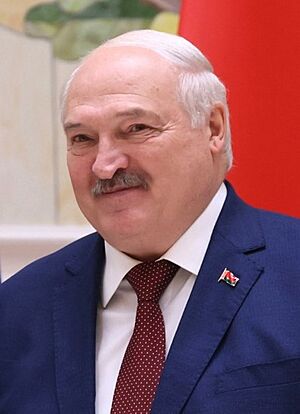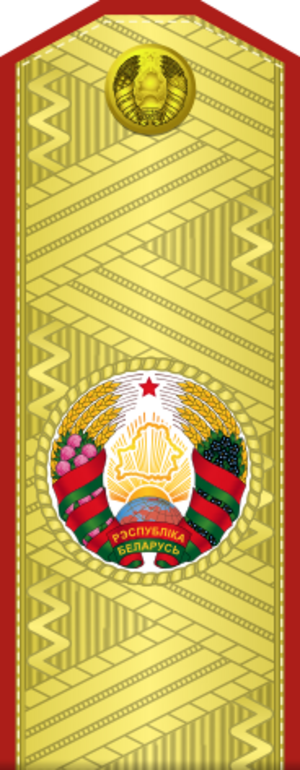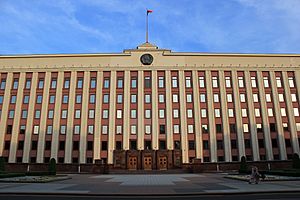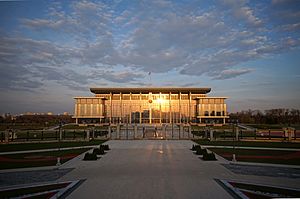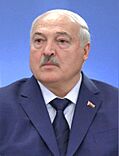President of Belarus facts for kids
Quick facts for kids President of theRepublic of Belarus |
|
|---|---|
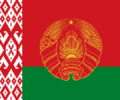
Presidential standard
|
|
| Presidential Administration of Belarus | |
| Style | Mr President (informal) His Excellency (diplomatic) |
| Residence | Independence Palace, Minsk (ceremonial) Presidential Residence, Minsk (residential) |
| Appointer | Popular vote |
| Term length | Five years,
renewable once
|
| Constituting instrument | Constitution of Belarus (1995) |
| Precursor | Chairman of the Supreme Council |
| Formation | 20 July 1994 |
| First holder | Alexander Lukashenko |
| Deputy | Prime Minister |
| Salary | ~84,000 Belarusian rubles/US$33,600, annually |
The President of the Republic of Belarus is the country's leader. This important job was created in 1994. It happened when Belarus passed its Constitution. Before that, the leader was called the Chairman of the Supreme Council.
The president has many important tasks. They guide the country's plans both inside Belarus and with other countries. They also protect the rights and well-being of all citizens. The president makes sure the Constitution is followed. They are also the main person who represents Belarus to the rest of the world.
A president serves for five years. However, a vote in 1996 changed the election schedule. Another change in 2004 removed term limits. This meant a president could serve more than two terms. In 2022, a new vote brought back a limit of two terms. But this rule only applies to presidents elected after that change.
Elections for president have been held in 1994, 2001, 2006, 2010, 2015, 2020, and 2025. Alexander Lukashenko has been the only president of Belarus since the position began in 1994. The main office for the president is in the Palace of the Republic in Minsk. The president's home is in Zaslawye, a town near Minsk.
Some international groups have raised concerns about whether elections in Belarus are fair. They have also noted that people who disagree with the government sometimes face difficulties.
Contents
History of the Presidency
Belarus first became independent in 1918. It was called the Belarusian Democratic Republic. Its leader was the president of a temporary government group. In 1919, the Soviet Red Army forced this government to leave the country. It still exists today as a government in exile.
When Belarus was part of the Soviet Union, the real leader was the head of the Communist Party. This was the only legal political party at the time.
The Republic of Belarus became independent from the Soviet Union in 1991. From then until 1994, the head of state was the chairman of the Supreme Soviet. The prime minister was the head of the government. When the president's job was created, the prime minister's role became less powerful. The Supreme Soviet was also dissolved in 1996.
In the first presidential election, Alexander Lukashenko won. He defeated the prime minister, Vyacheslav Kebich. This made Lukashenko the first president. In later elections, Lukashenko won again. Some international observers have noted that these elections did not meet democratic standards. As of 2025, Alexander Lukashenko is the only person who has served as President of Belarus.
President's Role in the Constitution
Article 79 of the Constitution of Belarus explains the president's role. It says the president is the head of state. They also protect the Constitution and the rights of citizens. The president represents Belarus when dealing with other countries. They also work to keep the country safe and stable. The president helps different parts of the government work together.
While in office, the president cannot be a formal member of a political party.
How a President is Chosen
Who Can Be President?
To become president, a person must be a Belarusian citizen from birth. They must be over 35 years old. They also need to have lived in Belarus for at least ten years. And they must be legally allowed to vote. These rules are in Article 80 of the Constitution.
Getting Nominated and Elected
Presidential elections happen every five years. Citizens vote for their president. To become a candidate, a person needs a group of at least 100 citizens to support them. This group must register with the Central Elections Commission. This has to happen at least 85 days before the election.
If registered, the candidate then needs to collect 100,000 valid signatures from voters. If they get enough signatures, they are officially allowed to run for president.
During the election, people vote secretly. The election is only valid if more than 50% of registered voters cast a ballot. In the first round of voting, if a candidate gets more than half of the votes, they win. If no one gets enough votes, the two candidates with the most votes go to a second round. The person who gets the most votes in the second round becomes president.
If the president's job becomes empty, a new election must happen quickly. It must be held between 30 and 70 days after the job became empty. Normally, elections happen in the last two months of the current president's term. The House of Representatives is the government group that calls for elections. The last presidential election took place in 2025.
What the President Does
Articles 84 and 85 of the Constitution list the president's official duties. These include political, social, and national defense tasks. The president can also use other powers given by law or the Constitution.
The president can call for national votes, called referendums. They can also call for regular elections for the House of Representatives and other local groups. The president can even dissolve, or close down, both parts of the Parliament.
It is the president's job to appoint the Prime Minister. They also decide how the government will be set up. The president signs new laws. They can also reject a law, or parts of it, and send it back to the House of Representatives. The president also appoints and can remove deputy prime ministers and other government members. They decide if the government, or any of its members, should resign.
The president appoints the head of the Supreme Court. They can also remove this person and other judges. The president gives yearly speeches to the Parliament. They can also attend Parliament meetings. If there is a strike, the president can stop or delay it for up to three months. In international matters, the president leads talks and signs agreements with other countries. They also appoint and recall Belarus's ambassadors.
The president is not just the head of government. They are also a social leader for Belarus. The president gives speeches to citizens several times a year. They can also create new national holidays. The president is the main person who grants Belarusian citizenship. They can also give out state awards to people who have done great things. The president can decide the status of people seeking safety in Belarus. They can also grant pardons to people who have been found guilty of crimes.
The president is the supreme commander-in-chief of the Belarusian Armed Forces. This means they are in charge of protecting Belarus from threats. The president can declare a state of emergency if there are natural disasters, big accidents, or violent unrest. If this happens, the Council of the Republic must be told and approve it within three days. The same rules apply if the president declares martial law because of a possible war. The president also forms and leads the Security Council of Belarus. They can appoint and remove its state secretary and the top military commanders.
Taking the Oath of Office
Before officially starting the job, a new president must take an oath. This must happen within two months after the election results are final. The oath says:
Assuming the office of President of the Republic of Belarus, I solemnly swear to faithfully serve the people of the Republic of Belarus, to respect and safeguard the rights and liberties of man and citizen, to abide by and protect the Constitution of the Republic of Belarus, and to discharge strictly and conscientiously the lofty duties that have been bestowed upon me.
Many important people attend the ceremony. These include members of the National Assembly, government ministers, and judges. After the oath is read, the powers of the previous president are given to the new president. The words of the oath are in Article 83 of the Constitution.
Leaving the Office
Articles 87 to 89 of the Constitution explain how a president can leave office before their term ends. The president can resign at any time. They send a letter of resignation to the House of Representatives, which accepts it.
A president can also be removed if their health prevents them from doing their job. For this to happen, two-thirds of the House of Representatives and the Council of the Republic must agree. A special committee checks the president's health first.
If the president commits a serious crime, like treason, one-third of the House can bring charges. The Council of the Republic then investigates these charges. To remove the president, two-thirds of the Council must vote to convict them. The case is then sent to the Supreme Court for review. These actions must happen within one month, or they are not valid.
Presidential Buildings and Protection
Under Article 79 of the Constitution, the president cannot be arrested. The only exception is for serious crimes like treason, as mentioned in Article 88. Also, national law protects the president's honor and dignity. It is illegal to print or report false information that harms the president's reputation.
The Presidential Palace is a large building in Minsk. It is located on October Square. This building used to be the headquarters for the Communist Party. Since 1994, it has been used by the president. Streets near the palace are closed to cars and guarded by police. The president also uses the Independence Palace in Minsk.
Symbols of the President
The main symbol of the president is the flag of the president of Belarus. This flag has been used since March 27, 1997. President Lukashenko signed a decree to adopt it.
The flag looks like the national flag. But it also has the Belarusian national emblem in gold. The presidential flag is almost square, with a ratio of 5:6. It also has a golden border. There are several copies of this flag. The original is kept in the president's office. Other copies are used on buildings, homes, and vehicles to show the president is present.
Presidents of Belarus (1994–Present)
| No. | Portrait | Name (born–died) |
Term of office | Political party | Elected | |||
|---|---|---|---|---|---|---|---|---|
| Took office | Left office | Time in office | ||||||
| 1 | Alexander Lukashenko (born 1954) |
20 July 1994 | Incumbent | 31 years, 163 days | Independent (close to Belaya Rus) |
1994 2001 2006 2010 2015 2020 2025 |
||
In the 2020 election, Lukashenko was re-elected for his sixth term. Sviatlana Tsikhanouskaya was the main opposition candidate. She later created the Coordination Council.
See also
 In Spanish: Presidente de Bielorrusia para niños
In Spanish: Presidente de Bielorrusia para niños
- List of national leaders of Belarus
- Academy of Public Administration
- Presidential Administration of Belarus
- Chief of Staff to the President of Belarus


